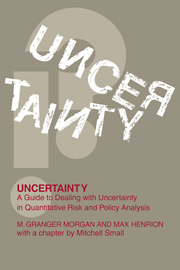Book contents
- Frontmatter
- Contents
- Preface
- 1 Introduction
- 2 Recent Milestones
- 3 An Overview of Quantitative Policy Analysis
- 4 The Nature and Sources of Uncertainty
- 5 Probability Distributions and Statistical Estimation
- 6 Human Judgment about and with Uncertainty
- 7 Performing Probability Assessment
- 8 The Propagation and Analysis of Uncertainty
- 9 The Graphic Communication of Uncertainty
- 10 Analytical A Software Tool for Uncertainty Analysis and Model Communication
- 11 Large and Complex Models
- 12 The Value of Knowing How Little You Know
- Index
6 - Human Judgment about and with Uncertainty
Published online by Cambridge University Press: 05 June 2012
- Frontmatter
- Contents
- Preface
- 1 Introduction
- 2 Recent Milestones
- 3 An Overview of Quantitative Policy Analysis
- 4 The Nature and Sources of Uncertainty
- 5 Probability Distributions and Statistical Estimation
- 6 Human Judgment about and with Uncertainty
- 7 Performing Probability Assessment
- 8 The Propagation and Analysis of Uncertainty
- 9 The Graphic Communication of Uncertainty
- 10 Analytical A Software Tool for Uncertainty Analysis and Model Communication
- 11 Large and Complex Models
- 12 The Value of Knowing How Little You Know
- Index
Summary
We dance around in a ring and suppose,
But the secret sits in the middle and knows.
Robert FrostWhen the value of an uncertain quantity is needed in policy analysis, and limits in data or understanding preclude the use of conventional statistical techniques to produce probabilistic estimates, about the only remaining option is to ask experts for their best professional judgment. The past twenty years have witnessed remarkable progress in the development of understanding of how both experts and laypersons make judgments that involve uncertainty. Much of this new knowledge is directly relevant to problems encountered in quantitative policy analysis, especially to the elicitation of subjective probability distributions from experts.
We begin this chapter with a brief look at the psychology of judgment under uncertainty. We then turn to a somewhat more detailed review of experimental findings on the psychology, and some of the mechanics, of probability assessment. Most findings reported involve “encyclopedia”-type questions posed to nonexpert subjects. We close the chapter by examining the question “are experts different?” We defer until Chapter 7 a discussion of practical protocols for probability assessment.
The Psychology of Judgment under Uncertainty
When, as experts or laypersons, we think about and make judgments in the presence of uncertainty, we make use of a set of heuristic procedures. These procedures serve us well in many circumstances (Nisbett and Ross, 1980).
- Type
- Chapter
- Information
- UncertaintyA Guide to Dealing with Uncertainty in Quantitative Risk and Policy Analysis, pp. 102 - 140Publisher: Cambridge University PressPrint publication year: 1990
- 4
- Cited by



